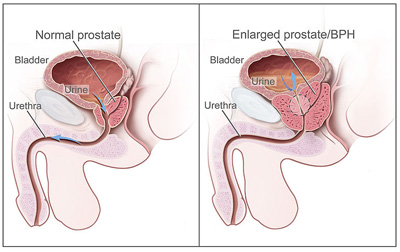Difference Between BPH and Prostate Cancer
Difference Between Benign Prostatic Hyperplasia (BPH) and Prostate Cancer
Benign prostatic hyperplasia is a condition that occurs in 50% of men over the age of 45. However, in certain cases, it may be indicative of prostate cancer. How do you make out whether your enlarged prostate is a symptom of prostate cancer? Read on!
The prostate is a small walnut sized organ present around the urethra. After puberty, it may start growing again when a man is 40 years of age. Benign or non cancerous enlargement of the prostate is a very common prostate problem in men. In fact, almost all men will develop some sort of prostate enlargement as they age.
The good news is, more than one third of men do not require treatment for their enlarged prostates. If you are worried about your enlarged prostate being a symptom of prostate cancer, you are probably wrong.
While it is true that benign prostatic hyperplasia (BPH) and prostate cancer have similar symptoms, the chances of you having prostate cancer are very little. However, it is a fact that a thorough evaluation by your doctor is the best way to assure yourself that you don’t have prostate cancer.
Another important reason why you should go for an early evaluation is that you have more chances of securing a cure if you detect the cancer early. This is all the more relevant for people who have a high risk of developing cancer. For instance, men who have a family history of prostate cancer and African Americans should begin screening for prostate cancer at around 45 years of age.
There are no established reasons why a person gets BPH. It is not even clear whether a particular group is more predisposed towards the disease. However, it can be said with some certainty that people, who have close family members suffering from prostate cancer, are more likely to get the condition themselves.
Prostate cancer and BPH share the same symptoms. For instance, you may experience frequent urination and difficulties in urination for both conditions. You may also experience interruptions in urination.
The difference in the two conditions is that prostate cancer occurs on the lateral lobes of the prostate. It usually spreads to the pelvis and the spine also. BPH is more or less centralized and does not spread to other tissues.
Both BPH and prostate cancer may cause elevated results in PSA tests. However, only those with prostate cancer will display an increase in bone alkaline phosphatase levels.
If a person is diagnosed with prostate cancer, his treatment will naturally differ from that of a person who has BPH only. Depending on the stage of the cancer, the doctor may prescribe radiation therapy, hormones or a surgery.
People with only BPH are usually not prescribed any treatment at all. The doctor may also advise medications like Finasteride or surgery to remove tissues that are obstructing the organ.
BPH is not indicative of prostate cancer. However, getting it evaluated by a doctor is the smart thing to do.
- Difference Between Radiation and Chemo - February 15, 2024
- Difference Between DNA and Genes - February 15, 2024
- Difference Between Aorta and Pulmonary Arteries - December 16, 2009

